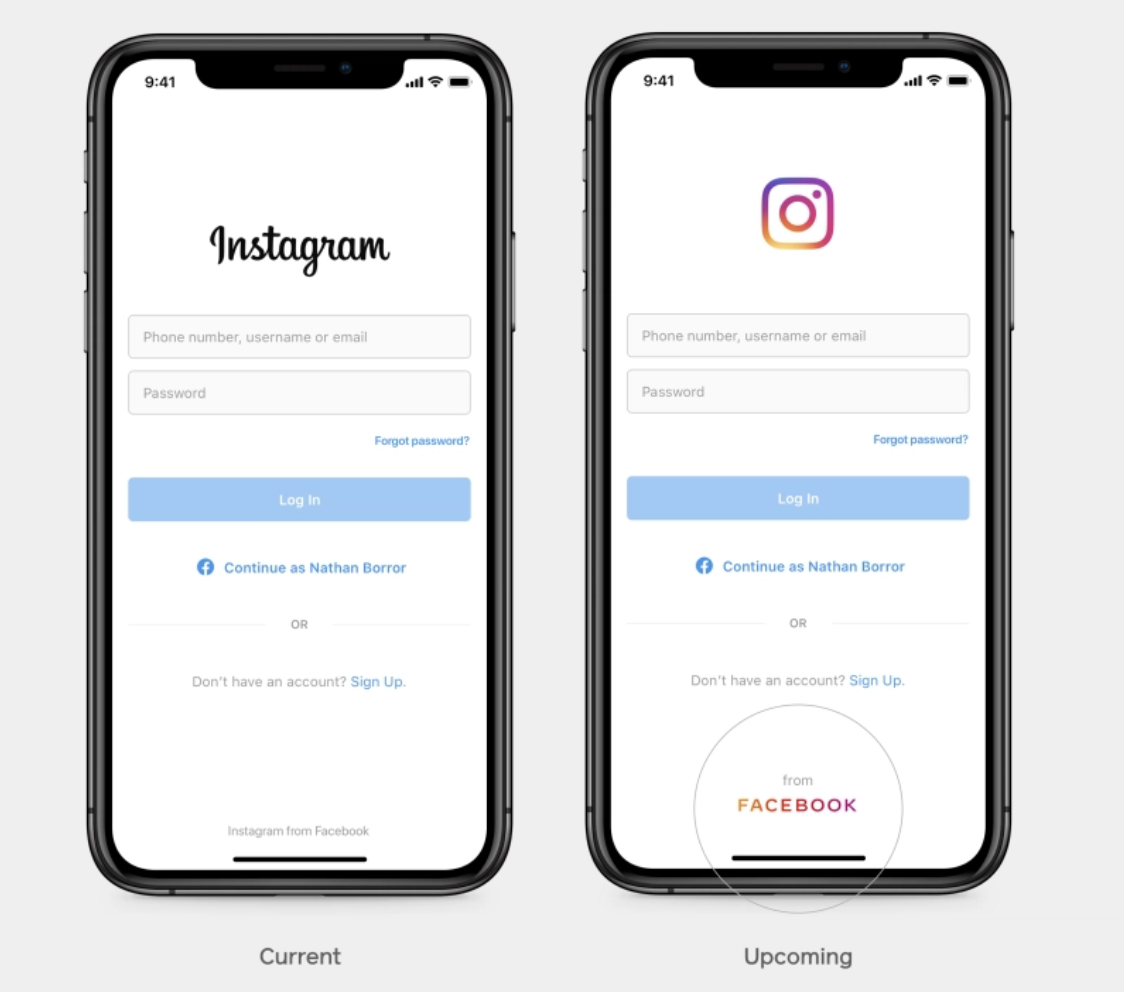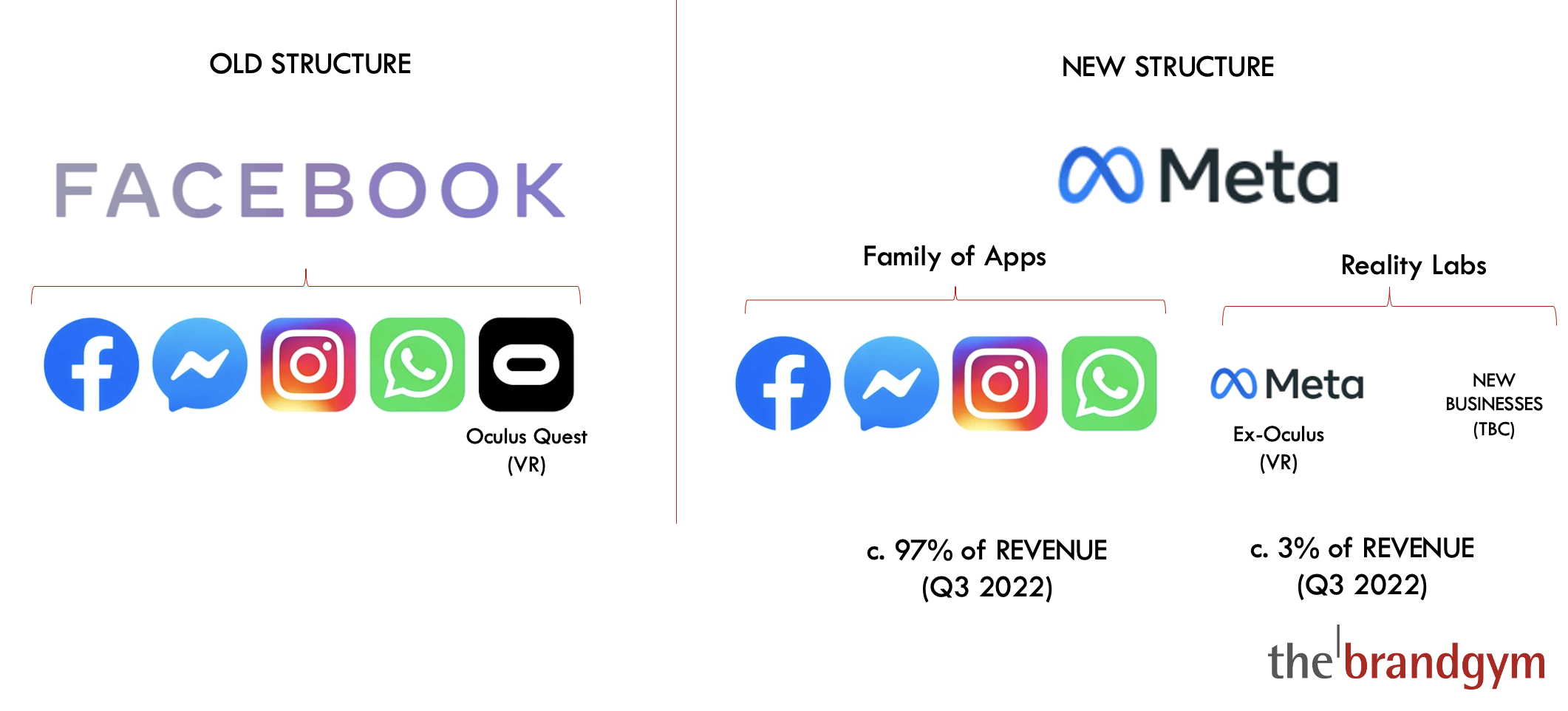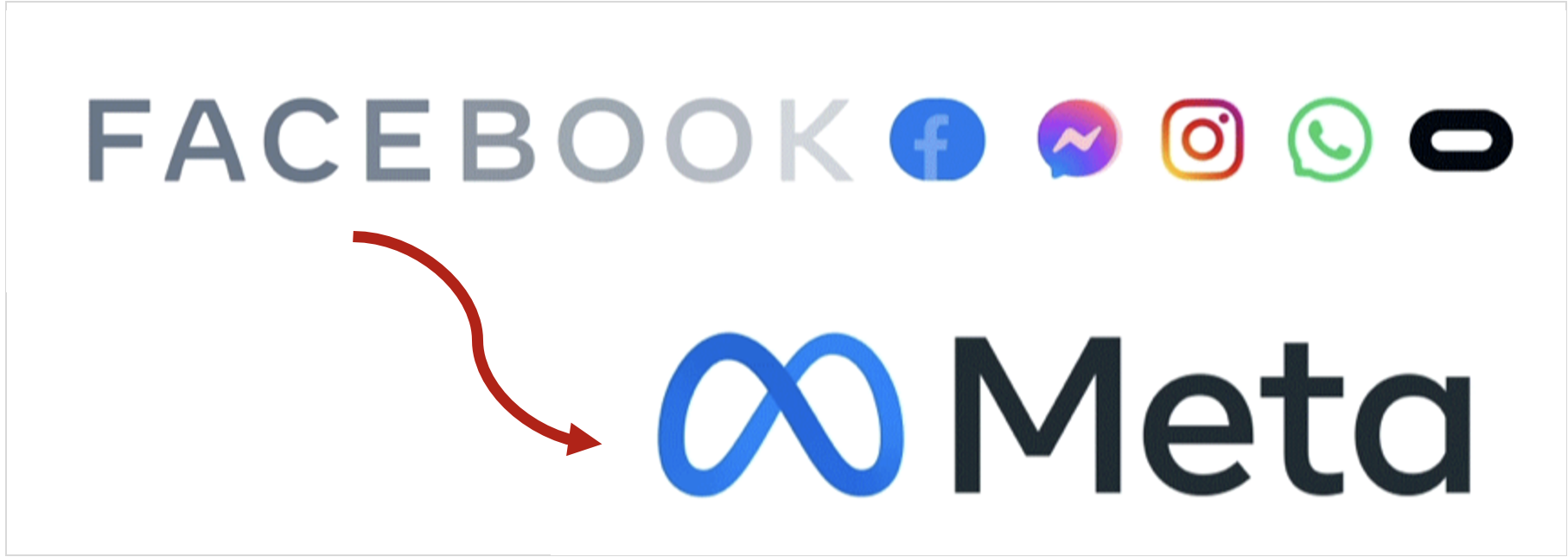The change of Facebook’s company brand name change to Meta hit the headlines last week. In this post, I take a practical look at the good, bad and ugly aspects of the re-branding. What can we learn about how to approach a change to a company’s brand architecture?
What is the branding change?
It the Facebook company brand that has changed to Meta. The actual Facebook product brand remains unchanged. The target audience here is not so much end users, but rather investors, employees (current and future) and regulators.
This distancing of the holding company from the Facebook brand is a radical reversal of brand strategy. Only two years ago, a ton of time and money was spent updating the Facebook company logo and adding it as endorsement to the company’s apps (see below). “People should know which companies make the products they use,” stated CMO Antonio Lucio. “We’re updating our branding to be clearer about the products that come from Facebook.” (1)
The Meta name change is accompanied by a change in reporting structure. “Starting with our results for the fourth quarter of 2021, we plan to report on two operating segments: Family of Apps (e.g. Facebook, Instagram, Messenger, WhatsApp) and Reality Labs” CEO Mark Zuckerberg explained in a recent blog (2).

The Good: focus on the future
On the positive side, the name change to Meta is based on a vision of the future. All brand strategy should ‘start with the end in mind’: the future ambition for your brand and business.
In the case of Mark Zuckerberg, he is convinced that the future is about ‘the metaverse’ and believes this has implications for the company brand. “The metaverse is the next frontier,” he is reported as saying in the FT (3). “Right now our brand is so tightly linked to one product [Facebook] that it can’t possibly represent everything we’re doing today, let alone in the future.”
Exactly what the metaverse is remains unclear, as it doesn’t actually exist yet! “The metaverse will feel like a hybrid of today’s online social experiences, sometimes expanded into three dimensions or projected into the physical world,” is how Meta explains it. “Moving beyond 2D screens toward immersive experiences like augmented and virtual reality.” (3) Zuckerberg demonstrated an example of what this all might look like by talking to an avatar of himself in the live-streamed conference used to announce the name change.
The Bad: losing focus on the core
‘Brand architecture’ is about more than just names and logos. It also guides investment decisions. And my concern with the new company name is its single-minded focus on the nascent metaverse offer, at a time when the core social media apps are in need of revitalisation.
Facebook and Instagram are still huge money earners. Third quarter sales increased 33% to $29 billion. But Tik Tok is in the ascendancy. It had double Facebook’s downloads in the US in Q2 2020, for example (4). Perhaps even more worrying is that Tik Tok was the favourite social platform for 29% of US teens in 2020, 14 times bigger than Facebook at just 2%, down from 21% in 2015 (5).
But despite the growing pressure on the core business, Zuckerberg’s attention seems to be on ‘the new toys’ in his massive empire. This is shown by the company name change and his spending plans. Meta plan to spend invest eye-popping $10bn on reality labs in 2022, with 10,000 people working on it and another 10,000 new hires planned. And yet the metaverse offer accounts for only 3% of revenue at the moment (6). This is mainly the Oculus virtual reality business, bought for $2billion in 2014. As part of the new naming strategy, the Oculus Quest VR headset will be renamed the Meta Quest, and the accompanying Oculus App will become the Meta App (7).

The heavy spend and minimal revenues means forecast losses of $7bn this year. And future rapid growth needed to pay back the huge investment is far from assured. Oculus has been “a tougher sell than expected, as virtual reality has only incrementally gained traction among non-gamers,” according to the FT (3). And after almost 20 years of investment, Linden Labs have struggled to build their Second Life virtual reality world. It saw rapid initial growth, but regular users declined from c. one million in 2013 to “between 800,000 and 900,000” by 2017 (8). This is a long way from founder Philip Rosedale’s 2003 prediction that a billion people would live life via their Second Life avatars (9).
The Ugly: failing to address the ‘toxic’ side of the brand
Most worryingly, the company name change does come across as a desperate attempt to distance the company from the negative publicity of recent weeks, with the ongoing revelations of Facebook whistleblower Frances Haugen. “Damaging documents show Facebook’s own research stating that Instagram was making some teenage girls’ body issues worse, while its own employees were warning that the firm’s algorithms were letting misinformation and hate speech ‘flourish’,” reports The Times (9).
Mike Davis, president of the Internet Accountability Project, likened the approach to that of ‘big tobacco’ in the 2000s (9). “Philip Morris got caught preying on kids, so they became Altria. Facebook got caught preying on kids so they became Meta.”
The company claims the name change was planned months ago. But the timing looks bad. It can be read as a lack of interest in addressing head on the negative effects of the core Facebook and Instagram products. This impression is reinforced by Zuckerberg saying only one sentence about the repetitional crisis in his recent address (9) and not clearly stating how he would address it. “With all the scrutiny and public debate, some of you might be wondering why we are doing this right now,” he said. “The answer is that I believe we are put on this Earth to create.”
A better brand architecture approach?
A better approach, I suggest, could have been to first build momentum in the new metaverse business to prove its potential. And then change the company name to reflect this success. This is the approach I posted on here when Park at my House changed name to Just Park, to reflect a growing offer beyond hiring parking places on peoples’ driveways.
Alternatively, a neutral name could have been chosen for the company brand, to act as an ‘umbrella’ across the core and new businesses. This was of course the approach used by Google, renaming the company as Alphabet. Although the actual effectiveness of this change is not clear. “Colloquially most people still call anything having to do with the company or its subsidiaries ‘Google’”, according to TechCrunch (10).
In conclusion, a company brand name change should be future-focused. But it should inspire core revitalisation, not only the development of nascent new businesses. Time will tell if Zuckerberg’s focus on the metaverse is a brilliant leap of faith or an example of a leader being distracted from the core at a time when the competition was hotting up. My bet is that the company name might undergo another change in two to three years time!
Sources:
